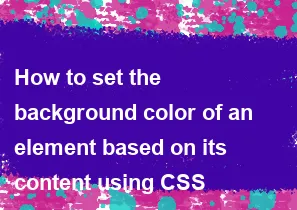How to set the background color of an element based on its content using CSS

You can use CSS and the :empty pseudo-class to target elements with no content and set their background color. Here's an example:
html<!DOCTYPE html>
<html lang="en">
<head>
<meta charset="UTF-8">
<meta name="viewport" content="width=device-width, initial-scale=1.0">
<title>Set Background Color Based on Content</title>
<style>
/* Set default background color */
.content-box {
background-color: #e0e0e0;
padding: 10px;
margin: 10px;
}
/* Override background color when content is present */
.content-box:empty {
background-color: #ffcccc; /* Set your desired background color */
}
</style>
</head>
<body>
<div class="content-box">
<!-- This box has content, so it will have the default background color -->
<p>This is some content.</p>
</div>
<div class="content-box">
<!-- This box has no content, so it will have the overridden background color -->
</div>
</body>
</html>
In this example, the .content-box class sets a default background color. The .content-box:empty selector then targets elements with the class that have no content and overrides the background color. You can adjust the colors and styles according to your preferences.
-
Popular Post
- How to optimize for Google's About This Result feature for local businesses
- How to implement multi-language support in an Express.js application
- How to handle and optimize for changes in mobile search behavior
- How to handle CORS in a Node.js application
- How to use Vue.js with a UI framework (e.g., Vuetify, Element UI)
- How to configure Laravel Telescope for monitoring and profiling API requests
- How to create a command-line tool using the Commander.js library in Node.js
- How to implement code splitting in a React.js application
- How to use the AWS SDK for Node.js to interact with various AWS services
- How to use the Node.js Stream API for efficient data processing
- How to implement a cookie parser middleware in Node.js
- How to implement WebSockets for real-time communication in React
-
Latest Post
- How to implement a dynamic form with dynamic field styling based on user input in Next.js
- How to create a custom hook for handling user interactions with the browser's device motion in Next.js
- How to create a custom hook for handling user interactions with the browser's battery status in Next.js
- How to implement a dynamic form with dynamic field visibility based on user input in Next.js
- How to implement a dynamic form with real-time collaboration features in Next.js
- How to create a custom hook for handling user interactions with the browser's media devices in Next.js
- How to use the useSWRInfinite hook for paginating data with a custom loading indicator in Next.js
- How to create a custom hook for handling user interactions with the browser's network status in Next.js
- How to create a custom hook for handling user interactions with the browser's location in Next.js
- How to implement a dynamic form with multi-language support in Next.js
- How to create a custom hook for handling user interactions with the browser's ambient light sensor in Next.js
- How to use the useHover hook for creating interactive image zoom effects in Next.js